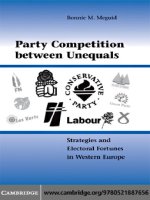052187484X cambridge university press choosing to die elective death and multiculturalism mar 2008
Bạn đang xem bản rút gọn của tài liệu. Xem và tải ngay bản đầy đủ của tài liệu tại đây (1.02 MB, 225 trang )
This page intentionally left blank
Choosing to Die
In this book, C. G. Prado addresses the difficult question of when
and whether it is rational to end one’s life in order to escape
devastating terminal illness. He specifically considers this question
in light of the impact of multiculturalism on perceptions and
judgments about what is right and wrong, permissible and impermissible. Prado introduces the idea of a ‘‘coincidental culture’’ to
clarify the variety of values and commitments that influence
decisions. He also introduces the idea of a ‘‘proxy premise’’ to deal
with reasoning issues that are raised by intractably held beliefs.
Primarily intended for medical ethicists, this book will be of
interest to anyone concerned with the ability of modern medicine
to keep people alive, thereby forcing people to choose between
living and dying. In addition, Prado calls upon medical ethicists
and practitioners to appreciate the value of a theoretical basis for
their work.
C. G. Prado is Emeritus Professor of Philosophy at Queen’s
University in Canada. He has published many books, most recently
Searle and Foucault on Truth and A House Divided: Comparing Analytic
and Continental Philosophy.
Choosing to Die
Elective Death and Multiculturalism
C. G. PRADO
Emeritus, Queen’s University
CAMBRIDGE UNIVERSITY PRESS
Cambridge, New York, Melbourne, Madrid, Cape Town, Singapore, São Paulo
Cambridge University Press
The Edinburgh Building, Cambridge CB2 8RU, UK
Published in the United States of America by Cambridge University Press, New York
www.cambridge.org
Information on this title: www.cambridge.org/9780521874847
© C. G. Prado 2008
This publication is in copyright. Subject to statutory exception and to the provision of
relevant collective licensing agreements, no reproduction of any part may take place
without the written permission of Cambridge University Press.
First published in print format 2008
ISBN-13 978-0-511-38607-7
eBook (EBL)
ISBN-13 978-0-521-87484-7
hardback
ISBN-13 978-0-521-69758-3
paperback
Cambridge University Press has no responsibility for the persistence or accuracy of urls
for external or third-party internet websites referred to in this publication, and does not
guarantee that any content on such websites is, or will remain, accurate or appropriate.
In memory of
Nancy Sutherland and Rose Candeloro Williams,
who chose to die;
and
Larry Baker, Hugheen Ferguson, Nathan Jaganathan,
Russ Savage, Carolyn Small, George Teves, and Bill White,
who didn’t
[A]ble to say a holy No when the time for Yes has passed.
Friedrich Nietzsche, Zarathustra
Contents
Preface
page ix
1
Setting the Stage
2
3
Criteria for Rational Suicide
Clarifying and Revising the Criteria
26
47
4
5
Application Issues
What Standards?
65
88
6
Relativism and Cross-Cultural Assessment
111
7
8
The Role of Religion
Assessment Latitude
135
158
9
The Realities of Cross-Cultural Assessment
179
1
Works Cited
Index
205
209
vii
viii
Preface
Book prefaces often are skipped. This one should be read because it
is important for readers to appreciate the intent and nature of what
follows and to whom it is addressed.
This book is about the rationality, and so the permissibility, of
choosing to die and is addressed to medical ethicists and to those on
their way to being medical ethicists. More particularly, the book is
addressed to medical ethicists who deal or will deal with terminal
patients. And most specifically, the book is addressed to those
who deal or will deal with terminal patients considering ending their
lives to escape the physical and personal devastation and torment
that many terminal conditions produce.
The writing of this Preface was prompted by events at a recent
conference on end-of-life issues to which I was invited. I presented
some material from the first two of the following chapters, with a
view to both sharing my observations with participants and seeking
constructive criticism.
The conference participants were mostly clinicians, with a significant number of health-care administrators and some lawyers specializing in terminal-illness issues. I regret that the comments and
questions about the material I presented made it clear that few in the
audience thought what I had to say was relevant to their work. My
commentator ridiculed the abstractness of my presentation and
dismissed my concern with the rationality of choosing to die by
saying simply that we cannot be rational in terminal suffering.
ix
x
Preface
In his closing remarks, the conference organizer attempted to
remedy matters by saying a little about the importance of the questions I raised. His remarks were well intentioned, but he succeeded
only in further marginalizing my position when he said I had spoken
about a ‘‘noble death’’ achievable only by a very few. However, he
summed up by asking a question that has stayed with me and that I
return to in Chapter 7. The question he asked was, ‘‘After all, how
many Socrateses die?’’1
While I was disappointed and frustrated by my commentator’s and
the audience’s reactions, I benefited from the experience. It brought
home to me how important it is to attempt to narrow an undeniable
communicative gulf that exists between theoreticians concerned with
end-of-life issues and clinicians and others who must deal directly
with those who are dying.
This gulf is precisely the one that medical ethicists must straddle.
The gulf has two aspects; one is perceptual. Medical ethicists are
usually perceived by theoreticians as clinicians because of their
applied work and regular contact with physicians, nurses, medical
administrators, and patients. But medical ethicists are seen as
theoreticians by clinicians and other practitioners because of their
educational backgrounds and contact with academic ethicists, epistemologists, psychologists, and often theologians. The second aspect
of the gulf is institutional and has to do with responsibility and
defined function. The fact is that medical ethicists are advisors; they
advise both clinicians and patients, as well as patient family members
and sometimes the clinics and hospitals in which they work. Medical
ethicists are not implementers or agents in the treatment of patients
and thus are distanced from clinicians in a manner that cannot be
changed by remedying misperceptions.
Medical ethicists, then, occupy a unique position, and in order to
function effectively they must balance theory and practice. Their
main job is to apply ethical theory to clinical situations and on that
basis to offer the best guidance they can to those who make the actual
treatment decisions. And this means that medical ethicists must
reconcile the sort of abstract considerations regarding rationality and
permissibility that this book discusses with the actualities of terminal
1
My thanks to David N. Weisstub for this productively provocative question.
Preface
xi
patients’ states of mind, pressures exerted by families, and physicians’
priorities, responsibilities, and liabilities. Regarding the choice to die,
medical ethicists stand between those who, like me, try to formulate
standards to govern the surrender of life in dire medical situations,
and those whose primary mandate and fiduciary responsibility is to
preserve life.
The unavoidable complication is that some terminally ill patients
do choose to die, that some physicians do assist in suicide, and that a
few even perform euthanasia for compassionate reasons. It is of
paramount importance, therefore, that medical ethicists be provided
with standards and especially a rationale on which to ground their
advice when patients choose to end their lives, whether by refusing
treatment or by taking more direct means. Without standards and
an underlying rationale, advising clinicians, patients, and family
members regarding terminal patients’ choices to end their suffering
can only be a more or less happenchance sequence of more and
less successful instances of coping with a recurring problem.
What prompted this book, as opposed to a planned third edition
of my The Last Choice,2 is that provision of standards and a rationale
for dealing with terminal patients have been greatly complicated
by the contemporary rise of multiculturalism and especially the
relativism inherent in it. The need to respect cultural values and their
influences on assessment standards, and factor them into policy
and particular decisions about end-of-life issues, has made dealing
with those issues greatly more complex than it was when policy and
decisions were made and assessed in the context of a single dominant
culture.
The key question, then, is not how many Socrateses die – though I
return to this question in Chapter 7. Rather the key question is, How
close can we come to emulating Socrates? The criteria I offer here,
and the consideration of how relativism and culture impact their
formulation and application, are intended to provide medical ethicists, as well as individuals considering ending their lives, with a basis
for assessing the rationality of choosing to die for medical reasons.
2
Prado, C. G. 1998. The Last Choice: Preemptive Suicide in Advanced Age, 2nd edition.
New York and Westport, Conn.: Greenwood and Praeger Presses.
1
Setting the Stage
This book is about the two most fundamental questions underlying
current debate about suicide, assisted suicide, and requested euthanasia in medical contexts. Those questions are whether choosing to
die rather than endure hopeless torment can be rational, and, if so,
whether it is morally permissible. Only if choosing to die is rational and
morally permissible can we go on to consider whether provision of
assistance in suicide or of euthanasia should be legalized and allowed
by codes of medical ethics.
The questions are hugely complex and cannot be asked without
provision of criterial contexts within which they can be answered. If it
is rational to choose to die, it is so within philosophical or conceptual
parameters. If it is morally permissible to choose to die, it is so within
either universal or culturally determined parameters. Moreover,
because most cases of choosing to die occur in institutions like hospitals and hospices, institutional cultures – the policies, priorities,
and practices of the relevant institutions – need to be considered in
establishing the latter parameters.
My original concern with choosing to die or what I call elective
death was purely philosophical: I focused on whether choosing to die
can be rational; that is, whether it can accord with reason and be judged
to be for the best. At the time I felt that if my work was applicable in
actual dealings with individuals prepared to die rather than face
personal and physical devastation, that was all to the good, but that was
not my main concern. Further work and especially growing familiarity
1
2
Choosing to Die
with medical ethics made me realize that I had to give a much higher
priority to the applicability of my criteria for rational suicide to the
cases medical ethicists and clinicians deal with in practice. Though the
rationality of choosing to die remains fundamental, I now see that it is
insufficient just to establish it. Criteria for rational elective termination
of life must be practically applicable. My aim in this book is to provide
medical ethicists both with practically applicable criteria for rational
and so possibly morally permissible elective death, and with clarification of the grounds of those criteria.
Ã
Ã
Ã
‘‘Rationality’’ is defined by the Oxford Companion to Philosophy as that
‘‘feature of cognitive agents that they exhibit when they adopt beliefs
on the basis of appropriate reasons.’’1 This definition captures that to
be rational is to rely on sound reasoning and evidence in adopting
beliefs and drawing conclusions. The definition, however, is incomplete because it focuses on the cognitive and is silent on the practical.
The Cambridge Dictionary of Philosophy defines rationality as ‘‘a normative concept . . . that, for any action, belief, or desire, if it is
rational we ought to choose it.’’2 The two definitions complement
one another, and they jointly capture what is central to assessing
choosing to die as rational, which is that the decision to end life is based on
sound reasoning, and that the act of ending life is for the best. This is the
sense of ‘‘rational’’ that I have used elsewhere in discussing choosing
to die and that I mean in everything that follows.
The question whether it is rational to choose to die is prior to those
more commonly asked about whether electing to give up life for
avoidance of or relief from great suffering is morally permissible, and
whether assistance in doing so should be allowed. If it is not rational
to choose to die, then elective death cannot be permissible by any
other standard. Only if it is first rational to choose to die do questions
legitimately arise about whether it can be morally permissible and
1
2
Honderich, Ted, ed. 1995. The Oxford Companion to Philosophy. Oxford: Oxford
University Press, 744.
Audi, Robert, ed. 1995. The Cambridge Dictionary of Philosophy. Cambridge:
Cambridge University Press, 674.
Setting the Stage
3
might properly be assisted. The priority of the rationality of choosing
to die is bedrock to my claims and arguments.
I have argued elsewhere that choosing to die can be rational.3
Here I recapitulate my arguments and the resulting criteria in order
to address the more familiar, and often more pressing, question
whether choosing to die may be morally permissible. Doing so
requires consideration of a number of issues I was earlier able to
avoid, chief among them being issues about how cultural values figure in reasoning about elective death. What mainly prompted me to
address the separate question of moral permissibility is the historically recent social development of widespread concern with
respecting diverse cultural values in assessment of most acts and
practices, including elective death.
The result of needing to deal with questions about the role of
diverse cultural values in assessing decisions and their enactment is
that consideration of elective death cannot remain at the abstract
philosophical level of thought about the pure rationality of choosing
to die. The issue of moral permissibility must be addressed. However,
that issue can no longer be addressed while presupposing a universal
morality. It is now necessary to factor in cultural diversity.
The way I go about determining the rationality and moral permissibility of elective death is by employing what one reviewer of this
project called ‘‘reflective equilibrium.’’ This involves venturing criteria, testing them against intuitions and critiques, and revising the
criteria to achieve a final version. I employ reflective equilibrium in
this and the next two chapters and again in applying the resulting
criteria in later chapters. The object of the exercise is to deal as
productively as possible with the complexity of the questions
about the rationality and moral permissibility of choosing to die.
Venturing and revising criteria shed light on the different aspects of
3
Prado, C. G. 1990. The Last Choice: Preemptive Suicide in Advanced Age. New York and
Westport, Conn.: Greenwood Group; Prado, C. G. 1998; The Last Choice: Preemptive
Suicide in Advanced Age, 2nd edition. New York and Westport, Conn.: Greenwood
and Praeger Presses; Prado, C. G. 2000a. ‘‘Ambiguity and Synergism in ‘Assisted
Suicide.’ ’’ In C. G. Prado, ed., 2000b. Assisted Suicide: Canadian Perspectives. Ottawa:
University of Ottawa Press, 43–60; Prado, C. G., and S. J. Taylor. 1999. Assisted Suicide:
Theory and Practice in Elective Death. Amherst, N.Y.: Humanity Books (Prometheus
Press). See also Prado, C. G., and Lawrie McFarlane. 2002. The Best Laid Plans: Health
Care’s Problems and Prospects. Montreal: McGill-Queen’s University Press.
4
Choosing to Die
the basic question about rationality and on application of the criteria.
I proceed, then, by first applying reflective equilibrium to my own
development of criteria for rational elective death, and then
segueing into consideration of establishing when elective death is
morally permissible. In this way, the basic conceptual issues that
concern elective death are illustrated, and I can then consider the
more practical issues that concern how cultural values bear on
abandoning life rather than enduring the pointless torment of some
terminal illnesses.
It merits mention that I realize much of what I recommend in this
book is already practiced by many medical ethicists. However, as
indicated in the Preface, the point of what follows is to articulate and
clarify the theoretical basis of what should be and often is done.
There also is the need to provide instruction on the underpinnings of
present practices for those new to medical ethics generally, or to the
issue of elective death in particular.
Ã
Ã
Ã
In 1990, when I published The Last Choice, my first book on suicide,
choosing to die to escape intolerable terminal conditions was
beginning to be accepted by medical professionals and in some cases
by the public. I agreed with Margaret Battin’s comment on the book’s
dust jacket that suicide would ‘‘replace abortion as the social issue’’ of
the 1990s. However, choosing to die in anticipation of intolerable
terminal conditions was still perceived as unacceptable and likely
pathological. Contrary to that view, I believed that preemptive or
anticipatory suicide is a rational option to avoid the personal and
intellectual diminishment and eventual devastation that terminal
conditions like Alzheimer’s disease and ALS (amyotropic lateral
sclerosis or Lou Gehrig’s disease) inflict on those who contract them.
I devised criteria for rational preemptive suicide done for medical
reasons, and while I thought their provision might be a little ahead of
time, I was confident they would soon be acknowledged as important
and useful.
Not many agreed with me. Even so ardent a supporter of the right
to die as Derek Humphry did not endorse preemptive suicide.
Humphry, who at the time was head of the Hemlock Society, made it
Setting the Stage
5
clear in his review of The Last Choice that his concern was limited to
affording terminally ill people the opportunity to end lives that were
already irredeemably ruined and increasingly unendurable.4 His
widely read and debated Final Exit exemplified that concern, being a
manual devoted to the curtailment of the slow and agonizing process
of dying from terminal illness.5
As matters worked out over the next eight years, Battin was proven
right; suicide did become a major social issue and Humphry’s
endorsement of suicide as release from pointless suffering came to be
shared by many, including legislators in Oregon and Australia.
Professional and public debate focused on surcease suicide, or on
choosing to die to escape present, intolerable circumstances, and
especially on assisted surcease suicide in medical contexts. The reason
for the latter focus is the problematic involvement of others, especially
physicians, in the enactment of decisions to die rather than face terrible medical situations. In 1998 I published an extensively revised
second edition of The Last Choice.6 By that time both professionals and
laypeople were more familiar with the complex issues of assisted suicide and so-called active and passive euthanasia, and I thought the
time had come for preemptive suicide to be taken seriously.
That did not happen, and it took me some time to understand what
should have been obvious from the start, which is that preemptive
suicide simply is not a social issue – at least in small numbers. Preemptive suicide really is the concern of the individual and perhaps
family and close friends. Professional involvement in preemptive suicide, where there is any, is largely limited to a physician, psychologist,
or psychiatrist consulted about the likelihood that a terminal illness will
develop and perhaps about the would-be suicidist’s competence to
make a life-and-death decision. Preemptive suicide is mainly the suicidist’s own business, and so neither a social nor professional concern
on the order of surcease and assisted surcease suicide considered and
committed while under medical care.
4
5
6
Humphry, Derek. 1992b. ‘‘The Last Choice.’’ Hemlock Quarterly, October, 4.
Humphry, Derek. 1992a. Final Exit: The Practicalities of Self-Deliverance and Assisted
Suicide for the Dying. New York: Dell.
Prado 1998.
6
Choosing to Die
Central to its low professional and public profile is that preemptive suicide does not pose questions about professional and legal
conflicts, and consequently draws little media attention and is rarely
publicly debated. Contrary to this, surcease and especially assisted
surcease suicide pose serious professional predicaments and readily
capture media and public attention: witness the extensive coverage
given to cases like that of Sue Rodriguez.7 What most captures media
and public attention is that these cases involve individuals who
choose to die to avoid surviving in intolerable circumstances, but who
for various reasons are physically unable to take their own lives and
must rely on the cooperation of their physicians or other caretakers
to help them die. These cases, then, essentially are about the conflict
between compassion and respect for professional ethics and the law;
they are about physicians’ conflicts between doing the best they can
for patients who are in hopeless situations and having to adhere to
legal and ethical requirements.8
My concern with preemptive suicide as a rational way of avoiding
insupportable personal destruction has not changed. I still see it as a
rational and advisable way of avoiding survival as a tormented and
much lessened shadow of oneself. However, I came to appreciate that
surcease suicide, assisted surcease suicide, and requested euthanasia
definitely constitute the social issue meriting primary attention. In
1999 and 2000 I published work on assisted suicide, and that has
been the focus of my thinking and research for the last several years.9
I still think that consideration of the rationality of preemptive suicide
is fundamental to better understanding of the rationality and moral
permissibility of surcease and assisted surcease suicide and of
requested euthanasia. The reason is that contemplation of preemptive suicide is conducted in the best possible circumstances: that is,
when the potential suicidist is not yet affected by the pressures and
7
8
9
Mullens, Anne. 1996. Timely Death: Considering Our Last Rights. New York: Alfred A.
Knopf.
Quill, Timothy. 1996. A Midwife Through the Dying Process: Stories of Healing and Hard
Choices at the End of Life. Baltimore and London: Johns Hopkins University Press;
Quill, Timothy. 2001. Caring for Patients at the End of Life: Facing an Uncertain Future
Together. New York: Oxford University Press.
Prado and Taylor 1999; Prado 2000a, 2000b.
Setting the Stage
7
uncertainties that inevitably accompany any terminal illness dire
enough to prompt thoughts of self-destruction. I believe that keeping
in mind how preemptive suicide can be a rational option for
someone can help clarify much about elective death that becomes
murky with the introduction of a pressing need for release from a
punishing condition. Nonetheless, I recognize that surcease suicide, assisted surcease suicide, and requested euthanasia pose the
pressing questions.
This new book, then, differs from my earlier ones in terms of focus.
But it also differs from earlier ones in other important ways. A second
way it differs is that it is written from a perspective reshaped by what I
have learned and thought about since publication of The Last Choice.
Thirdly, the book is written in light of the sea change in health-care
professionals’ and the public’s attitude toward suicide in terminal illness. Briefly put, in the past ten years there has been remarkably quick
growth of acceptance of elective death in hopeless medical situations.
This growth of acceptance is surprisingly due less to greater willingness to allow avoidance of pointless suffering than to the placing of a
higher value on the preservation of personal autonomy and dignity.
Perhaps as a legacy of the 1960s, or simply as a result of maturing
values, more and more people have come to appreciate the critical
difference between living and merely surviving. The idea of preserving life at all costs has waned in importance, and there has been
growing recognition that life is not of ultimate and unquestionable
value. Given this appreciation, someone’s choosing to die rather than
bear great suffering is now seen as wise and heroic, when not long ago
it was seen as cowardly and immoral, if not pathological.
A fourth, and perhaps the most noteworthy, way this book differs
from my earlier efforts is in its consideration of the impact of contemporary multiculturalism on the moral, social, and practical permissibility of elective death. At base, multiculturalism is equitable
recognition of diversity of belief and value systems and the imperative to respect and accommodate those differences in the assessment
of individual acts and of practices. It is no longer possible, then, to
discuss whether suicide, assisted suicide, or requested euthanasia is
permissible without taking into account how assessment standards
applied in particular cases of elective death are affected, if not
determined, by different cultural values.
8
Choosing to Die
It is important to appreciate at the outset that my concern with
multiculturalism is not political; it does not focus on the rights of
indigenous or immigrant minorities, as does so much present-day
discussion of and legislation regarding cultural diversity. Generic or
specific group-directed recognition or protection of ethnic, religious,
or linguistic minority rights is not what is at issue here. What is at
issue is that individuals reared and enculturated in diverse cultures
have diverse cultural values, and those values influence their perceptions and decisions regarding elective death – just as cultural values
influence whether a promiscuous young woman is seen and treated
as someone needing counseling and support or as defiled and
unmarriageable.
Most important to understanding the role of diverse cultural
values in deliberation and assessment of choosing to die is that the
multicultural imperative to respect the diversity of cultural values is
abandonment of construal of assessment standards as universal, as
cross-cultural, and so by intent or by default relativization of standards to culture. In Chapter 5 I consider more carefully how multiculturalism is relativistic; here it suffices to say that preparedness to
respect diverse cultural values, and all that entails regarding culturedefining beliefs and doctrines, requires that other cultures’ basic
beliefs not be merely tolerated as current in those various cultures.
Those beliefs must be accepted as legitimately held in their respective
cultures; that means they cannot be critically compared to beliefs held
in other cultures. Multiculturalism precludes judgmental assessment of
a given culture’s core beliefs from the perspective of another culture.
Multiculturalism is inherently relativistic: every culture’s defining
beliefs are as good as any other culture’s defining beliefs.
This relativization poses both a philosophical issue and a practical
one. The philosophical issue has to do with the acceptability and
scope of the entailed relativism; the practical issue has to do with the
inevitable disagreements due to different cultural beliefs and values
that arise in assessment of the choice to die. In the chapters that
follow it will be necessary to consider both issues to the extent that
they affect judgments about the rationality of choosing to die.
It is also important to appreciate that how multiculturalism is
considered and treated in what follows has little to do with established, particular, cultural suicidal practices, such as seppuku or
Setting the Stage
9
sallekhana. What concerns us is the role of cultural values in deliberating and assessing the rationality of choosing to die to avoid the
devastation of terminal illness, not specific cultural practices having
to do with forfeiture of life to avoid dishonor or demeaning capture,
or in the interests of political protest. Most identifiable and fairly
cohesive cultures have established notions of suicide, notions often
bound up with codes of honor or ritualized practices. But selfinflicted death for honor’s sake, as manifestation of loyalty, as fulfillment of obligation, as sacrifice for a greater good, and even as the
only avenue open to lovers from incompatible families or castes is not
relevant here except to the extent that these practices manifest a
culture’s general attitude toward elective death.
The first point to note, and one to which I return in Chapters 4
and 5, is that cultural attitudes toward elective death are often based
on religious doctrinal beliefs. To the extent that generalizations of
this sort are viable, it can be said that in Chinese culture, for instance,
attitudes toward elective death are mainly a function of Buddhist and
Confucian beliefs. Indian culture’s attitudes toward elective death are
mainly a function of beliefs rooted in Buddhism, Hinduism, and
Sikhism. Islam determines attitudes toward elective death in cultures
as different as those of Saudi Arabia and Indonesia. European, North
American, and Latin American attitudes toward elective death are
determined by Christianity, with perhaps the most negative being
those grounded in Catholicism. In these latter belief systems, life is a
gift from God and not one’s own to dispose of. Christianity, like other
religions, venerates its martyrs, but martyrdom, however deliberately
entered into, is still not self-inflicted death. The notable exception in
European culture is, of course, the Netherlands, which has pioneered –
if that is the appropriate term – elective death for medical reasons.
In any case, our concern is not with cultural specifics or, for that
matter, with whether attitudes toward elective death are religious or
secular in origin. Our concern in what follows is not with cultural
particulars but with the differences that diverse cultural values produce
in judgments about the acceptability of elective death. These judgmental differences pose a complication with respect to end-of-life
issues in that they are products of the application of varying standards
to the assessment of both policy and particular decisions about elective
death. But the application of varying standards is now inescapable.
10
Choosing to Die
Clearly cultures do differ with respect to the acceptability of choosing
to die, and assessment of terminally ill patients’ choices to die now
requires respect for the different cultural values held by those patients,
their families, those caring for them, and those assessing the acceptability of their choices.
There are still those who see multiculturalism as a passing phenomenon, but there are many others who see recognition of and
respect for different cultural perspectives as established and unavoidable in assessment of whether any act or practice is or is not permissible. In any case, as I consider in Chapter 6, the political reality of
multiculturalism in Europe and North America is now a given and not
soon to change. If only for the latter reason, it now would be intellectually disingenuous to discuss the moral, social, legal, medical,
and practical permissibility of elective death in terms of criteria
grounded on principles assumed to be cross-cultural in conception
and application.
Lastly, the fifth factor that helped to shape this book is my recognition of a persistent problem plaguing public debate about elective
death in medical contexts. The problem is the common running
together of assisted surcease suicide and voluntary euthanasia as
simply ‘‘assisted suicide.’’ This is a misuse of the concept of assisted
suicide, a misuse that fosters confusion about the differences between
genuine assisted suicide, on the one hand, and requested, voluntary,
and passive or even involuntary euthanasia. The main reason for
running these forms of elective death together is that the media and,
sadly, the public have little patience with distinctions between assistance in suicide and various forms of euthanasia where the patient is
not the primary agent in effecting death. If a physician or other clinician is involved in a patient’s death, ‘‘assisted suicide’’ is almost
invariably the label used to describe the case, regardless of the actual
nature of the action taken.
Another and somewhat darker reason for running together forms
of elective death where the terminal patient or the physician is the
primary agent as ‘‘assisted suicide’’ is that it usefully obscures just
whose decision it is to end a life, thus allowing courses of action that
physicians may follow in dealing with hopeless cases. These courses
of action run the gamut from clear cases of euthanasia to cases that
defy classification. The most common and perhaps least classifiable is
Setting the Stage
11
simply forgoing aggressive treatment. Another is allowing pneumonia to be contracted. I have personal knowledge of a case illustrating this option. The son of a woman with Alzheimer’s disease who
broke her hip was told by her doctor that after surgery pneumonia
would almost certainly develop. Its development was described as
‘‘a window of opportunity’’ regarding the release death offered.
However, a caring nurse turned the woman in her bed every twenty
or thirty minutes and she did not contract pneumonia; she lived
another three years. There are a number of other options, such as not
resuscitating a patient, whether or not there is a do-not-resuscitate
order in place, or simply delaying indicated treatment. More active
options include use of massive doses of painkillers or other drugs
whose use is justified by one aspect of a patient’s condition but
counterindicated by other aspects.
Most of the decisions to follow one or another of these courses of
action are not made by the patients themselves but by their attending
physicians, sometimes on their own, sometimes with the agreement
and support of family members or others with fiduciary responsibility
for the patients. Nonetheless, problematic use of the term ‘‘assisted
suicide’’ is often justified on the grounds that the course of action
taken is what the patient would have wanted or was in the patient’s best
interests. But the fact remains that current use of the term blurs crucial
differences between cases of elective death that are genuine assisted
suicide, in the sense of being the patient’s autonomous act done with
enabling help, and cases where someone other than the patient makes
the decisions to do or not do something that leads to death.
This book, then, is informed by a number of developments, the
most salient of which is the impact of the cultural relativism inherent
in multiculturalism on assessment of what is rational and morally
permissible. Relativization of standards and the truth of beliefs to
culture is central to what follows, and I take as a working definition of
cultural relativism that it is the view ‘‘that those who belong to one
culture cannot form a valid judgment of any custom, institution,
belief, etc. which is part of a culture which differs significantly from
their own.10 For the cultural relativist, then, all assessment of
10
Mautner, Thomas, ed. 2005. Dictionary of Philosophy, 2nd edition. London: Penguin
Books, 132.









